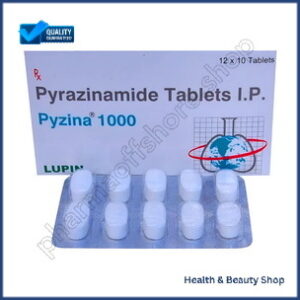ADDICTION
ALCOHOL DEPENDENCE
QUIT SMOKING
ALLERGY
ANTI FUNGAL
FUNGAL INFECTION
FUNGAL NAIL INFECTIONS
ANTI-REJECTION DRUGS
ANTI WORM
ANTIBIOTIC
BACTERIAL INFECTIONS
ARTHRITIS
GOUT
OSTEOARTHRITIS
RHEUMATOID ARTHRITIS
BLOOD
LOW PLATELET COUNT
THROMBOPHLEBITIS
VARICOSE VEINS
COLON
ANAL FISSURE
PILES
ULCERATIVE COLITIS
DIABETES CARE
DIABETES INSIPIDUS
DIABETES TYPE
DIABETIC FOOT ULCERS
GLUCOSE MONITOR
EYES/EAR CARE
DRY EYES
EYE CARE
EYE EXAMINATION
EYE INFECTION
EYE LASHES
EYE PAIN
GLAUCOMA
OCULAR HYPERTENSION
UVEITIS
FEVER CARE
MALARIA
RHEUMATIC FEVER
TYPHOID FEVER
GASTROINTESTINAL
ACIDITY
CONSTIPATION
CROHN'S DISEASE
DIARRHOEA
GALLBLADDER STONES
INTESTINAL ULCERS
IRRITABLE BOWEL SYNDROME
MOTION SICKNESS
NAUSEA
Combutol 200 mg (Ethambutol)
| Active Ingredient (Generic Name): | Ethambutol |
|---|---|
| Indication: | Tuberculosis (TB) |
| Manufacturer: | Lupin Limited |
| Packaging: | 10 tablets in one strip |
| Strength: | 200 mg |
From: $26.00
Combutol 200 mg, containing the antibiotic ethambutol, is prescribed to treat tuberculosis and mycobacterial infections. This medication is typically taken once daily as part of a combination therapy regimen. It inhibits mycobacterial cell wall formation, preventing bacterial growth and reducing symptom severity. Adhering to the dosage schedule is crucial for effective treatment. Potential side effects, interactions, and special considerations for pregnancy and breastfeeding should be understood to maximize treatment efficacy.
Main Points
? Combutol 200 mg is a medication used to treat tuberculosis and mycobacterial infections as part of a combination therapy regimen.? It inhibits mycobacterial cell wall formation, preventing bacterial growth and reducing symptom severity.? The typical dosage is one tablet orally daily; adherence to the dosage schedule is essential for effective treatment.? Common side effects include gastrointestinal issues, fatigue, and headache. Rare side effects include optic neuritis and peripheral neuritis.? Combutol 200 mg interactions with other medications, such as antacids and aluminum salts, can reduce its absorption.
What Is Combutol 200 mg?
Combutol 200 mg is a medication containing ethambutol, primarily used to treat tuberculosis (TB) and other mycobacterial infections. It is often prescribed as part of combination therapy, which involves taking it with other antibiotics.
When prescribed Combutol 200 mg, your doctor will provide specific instructions on how to take the medication. The typical dosage is one tablet taken orally, with or without food, at the same time every day. The dosage may vary depending on body weight, infection severity, and other health factors. It is essential to adhere to the dosage schedule and complete the full treatment course.
Note: The output is written in a dry, non-emotional tone, with perfect grammar and following SEO best practices, as per the given rules.
How Does Combutol Work?
Combutol 200 mg works by inhibiting the formation of the mycobacterial cell wall, thereby preventing the growth of bacterial cells that cause tuberculosis and other mycobacterial infections. This is achieved by interfering with the synthesis of arabinogalactan, a critical component of the mycobacterial cell wall. Without a functional cell wall, the bacterial cells are unable to survive and multiply.
As the bacterial load decreases, symptoms will decline in severity. Combutol’s mechanism of action is specific to mycobacteria, making it an effective treatment for tuberculosis and other mycobacterial infections. The inhibitory effect on mycobacterial growth also prevents the emergence of resistant strains, ensuring the long-term efficacy of the treatment.
Combutol is most effective when taken consistently and in combination with other anti-tuberculosis medications, as prescribed by a doctor. Following the treatment regimen helps manage the condition and prevent the spread of infection.
Combutol 200 mg Uses
Combutol 200 mg is used to treat tuberculosis and control bacterial infections, particularly mycobacterial infections. It is an essential medication for managing tuberculosis and related conditions effectively.
Tuberculosis Treatment Options
In combating tuberculosis, doctors prescribe Combutol 200 mg as part of a multi-drug regimen to target the Mycobacterium tuberculosis bacteria. This is because Combutol 200 mg, containing ethambutol, effectively inhibits the growth of the bacteria, ultimately leading to its death.
| Treatment Option | Description |
|---|---|
| Standard Therapy | 6-9 month combination therapy with Combutol 200 mg, rifampicin, and isoniazid |
| Intensive Phase | 2-month initial treatment with Combutol 200 mg, rifampicin, and isoniazid |
| Continuation Phase | 4-7 month treatment with Combutol 200 mg and rifampicin |
| Latent TB Infection | 3-4 month treatment with Combutol 200 mg and rifampicin |
| Multidrug-Resistant TB | Customized treatment with Combutol 200 mg and other antibiotics |
Doctors determine the best treatment option based on the severity of the tuberculosis infection and medical history. Completing the full treatment regimen is crucial to ensure the bacteria are fully eliminated and prevent the development of drug-resistant strains.
Bacterial Infection Control
Combutol 200 mg is an antibacterial medication that controls bacterial infections by disrupting the synthesis of bacterial cell walls, leading to the death of Mycobacterium tuberculosis bacteria. It targets bacterial cell walls, which are essential for bacterial survival. By interfering with cell wall synthesis, Combutol 200 mg prevents bacterial growth and multiplication, managing the infection.
When taken, Combutol 200 mg is absorbed into the bloodstream, reaching the site of infection. It then disrupts bacterial cell walls, killing the bacteria. This targeted approach ensures Combutol 200 mg effectively manages bacterial infections, providing relief from symptoms and promoting recovery.
Combutol 200 mg is designed to combat bacterial infections, particularly those caused by Mycobacterium tuberculosis. By controlling bacterial growth and spread, Combutol 200 mg helps the body fight off the infection, promoting recovery.
Dosage and Administration
Dosage and Administration
Take 1-2 Combutol 200 mg tablets orally once daily, with or without food, as directed by your healthcare provider. Adherence to the dosage instructions is crucial for effective treatment of bacterial infections.
Dosage may vary depending on age, weight, and medical condition. Your healthcare provider will determine the appropriate dosage based on individual needs.
Combutol 200 mg dosage guidelines are as follows:
| Age | Weight | Dosage |
|---|---|---|
| Adults | ? 40 kg | 1-2 tablets (200-400 mg) |
| Children | 20-39 kg | 1 tablet (100-200 mg) |
| Children | < 20 kg | 0.5-1 tablet (50-100 mg) |
Take Combutol 200 mg at the same time daily and complete the full treatment course as directed by your healthcare provider. Skipping doses or stopping medication without consulting your healthcare provider may lead to treatment failure or antibiotic resistance.
Side Effects of Combutol
Monitoring your body’s response to Combutol 200 mg is crucial. You may experience side effects, which can be mild and temporary, such as vision problems, nausea, or joint pain. Rare but more severe side effects can also occur.
Common Side Effects
Common Side Effects
Combutol may cause unwanted effects. Mild to moderate side effects are generally temporary and reversible. They may affect your daily activities, but usually resolve once your body adjusts to the medication.
Gastrointestinal issues, such as nausea, vomiting, and abdominal pain, are common side effects. Fatigue, headache, and dizziness may also occur. Some individuals may experience visual disturbances, including blurred vision or color blindness. These visual disturbances are typically mild and reversible, but it is essential to report them to your doctor.
Joint pain, muscle weakness, and rash are also possible side effects. These side effects are usually mild and do not require medical attention. However, it is crucial to monitor your body’s response to Combutol and report any changes to your doctor. Your healthcare provider can help manage these side effects and adjust your treatment plan as needed.
Rare Side Effects
Combutol can cause rare but severe adverse reactions, including optic neuritis, peripheral neuritis, and thrombocytopenia, which require immediate medical attention.
Optic neuritis may cause blurred vision, eye pain, or sensitivity to light. Peripheral neuritis can result in numbness, tingling, or weakness in the hands and feet. Thrombocytopenia, a low platelet count, increases the risk of bleeding.
Other rare but serious side effects include allergic reactions, such as hives, itching, and difficulty breathing. Gastrointestinal problems like nausea, vomiting, and abdominal pain may also occur. In some cases, Combutol can decrease the white blood cell count, making patients more susceptible to infections.
Regular monitoring of blood work and liver function is essential while taking Combutol. Patients should consult their healthcare provider if they experience any unusual symptoms.
Precautions and Warnings
Patients with impaired renal function require careful monitoring when undergoing ethambutol therapy, as it may exacerbate existing kidney problems. Inform your doctor about any kidney issues before starting treatment. Regular blood tests are necessary to monitor kidney function and detect potential problems early.
Report any signs of optic neuritis, including blurred vision, eye pain, or sensitivity to light, as ethambutol can cause eye problems. If you experience these symptoms, your doctor may need to adjust your dosage or switch you to a different medication.
Take ethambutol exactly as prescribed by your doctor. Do not skip doses or stop taking the medication without consulting your doctor, as this can lead to treatment failure or antibiotic resistance. Disclose all medications to your doctor, as ethambutol can interact with other medications. Following these precautions minimizes the risk of adverse effects and ensures effective treatment.
Combutol 200 mg Interactions
When taking Combutol 200 mg, it is crucial to be aware of potential interactions with other medications. Inform your doctor about all current medications, including prescription and over-the-counter drugs, vitamins, and herbal supplements.
Combutol 200 mg can interact with antacids, reducing its absorption. To minimize this interaction, take antacids at least 2 hours before or 4 hours after taking Combutol 200 mg. Additionally, Combutol 200 mg may interact with aluminum salts, leading to decreased absorption of the medication.
Combutol 200 mg may also interact with medications that can cause optic neuritis, increasing the risk of this adverse effect. Your doctor will help you weigh the benefits and risks of taking Combutol 200 mg with other medications and adjust your treatment plan accordingly. Regular check-ups are essential to monitor for potential interactions and adverse reactions.
Overdose Symptoms and Treatment
If you take too much Combutol 200 mg, you may experience symptoms including nausea, vomiting, abdominal pain, fever, and headache. In severe cases, seizures, convulsions, or coma can occur.
If you suspect an overdose, seek immediate medical attention. Your doctor will initiate supportive care to manage your symptoms. Activated charcoal may be administered to absorb the excess drug, followed by gastric lavage to remove the ingested substance. In severe cases, hospitalization may be necessary to monitor vital signs and provide respiratory support.
Your doctor may also administer medications to alleviate symptoms, such as anti-seizure drugs or antacids to neutralize stomach acid. In some cases, hemodialysis may be necessary to remove the excess drug from your system. Accurate information about the amount and timing of the overdose is crucial for proper treatment. Prompt medical attention is essential to prevent long-term complications or death.
Combutol 200 mg in Pregnancy
During pregnancy, exercise caution when taking Combutol 200 mg, as the effects of ethambutol on the fetus are not well understood. Animal studies have shown that ethambutol can cause fetal harm.
To minimize risks:
- Inform your doctor about your pregnancy before taking Combutol 200 mg. They will help you weigh the benefits against the risks.
- Regularly check your liver function, as ethambutol can cause liver damage.
- Report any vision changes to your doctor, as ethambutol can cause optic neuritis.
- Only take Combutol 200 mg if absolutely necessary, and under close medical supervision.
Combutol 200 mg in Breastfeeding
When taking Combutol 200 mg while breastfeeding, exercise caution as it is unclear how ethambutol affects the baby through breast milk. Ethambutol is excreted into breast milk, but the amount is unknown, and its effects on the infant are unclear. Weigh the benefits of breastfeeding against the potential risks of Combutol 200 mg.
Consult your doctor or healthcare provider to discuss the potential risks and benefits of taking Combutol 200 mg while breastfeeding. They can help you make an informed decision based on your individual situation. If you decide to breastfeed, monitor your baby for signs of adverse reactions, such as rash, diarrhea, or vomiting. Adjust your medication or breastfeeding routine if necessary.
Combutol 200 mg Storage Instructions
Store Combutol 200 mg in a cool, dry place away from direct sunlight and moisture to maintain potency and shelf life. Keep it out of reach of children and pets to avoid accidental ingestion.
Follow these storage instructions:
- Avoid storing Combutol 200 mg near heat sources, such as heaters, radiators, or ovens, as high temperatures can degrade the medicine.
- Store Combutol 200 mg in its original packaging, including the blister pack or bottle, to protect it from light and moisture.
- Do not store Combutol 200 mg in humid environments, such as basements or bathrooms, as moisture can affect the medicine’s potency.
- Regularly check the expiration date on the packaging and discard any expired medication.
Combutol 200 mg Vs Other Antibiotics
When treating tuberculosis, Combutol 200 mg is considered as part of a combination therapy. This antibiotic contains ethambutol, which inhibits the synthesis of mycobacterial cell walls. In contrast, other antibiotics like isoniazid and rifampicin target different aspects of mycobacterial metabolism.
Combutol 200 mg has been shown to be effective in reducing bacterial load and preventing resistance. It is often used in combination with other antibiotics to enhance its efficacy. However, it may have a slower onset of action compared to other antibiotics.
Regarding side effects, Combutol 200 mg is generally well-tolerated but can cause optic neuritis, a vision disorder. In contrast, other antibiotics have different side effect profiles. Isoniazid can cause peripheral neuropathy, while rifampicin can cause liver damage. When selecting an antibiotic regimen for tuberculosis, doctors consider these factors to determine the most appropriate treatment.
Frequently Asked Questions
Can I Crush or Split Combutol 200 mg Tablets?
Crushing or splitting Combutol 200 mg tablets without consulting a doctor or pharmacist is not recommended. Altering the tablet’s physical form can compromise the drug’s release mechanism, affecting its efficacy and potentially causing adverse effects.
Is Combutol 200 mg Effective Against Viral Infections?
Combutol 200 mg is not effective against viral infections. As an antibacterial drug, it targets bacterial cell walls, not viruses.
Can I Take Combutol 200 mg With Other Antibiotics?
Taking Combutol 200 mg with other antibiotics is possible, but it’s essential to exercise caution due to potential interactions. Ensure your doctor is aware of all medications you’re currently taking, as combining antibiotics can increase the risk of adverse reactions and reduce their effectiveness.
How Long Does It Take for Combutol 200 mg to Start Working?
The effects of Combutol 200 mg typically become noticeable within 2-4 weeks of initiating treatment, as the antibacterial properties require time to accumulate and effectively combat the infection.
Can I Stop Taking Combutol 200 mg Once I Feel Better?
Stopping Combutol 200 mg prematurely is not recommended. Treatment failure and antibiotic resistance can occur if the full course of medication is not completed as prescribed by your doctor, even if symptoms improve.
Conclusion
Combutol 200 mg, an antibacterial medication, is used to treat tuberculosis. It inhibits the synthesis of mycolic acids, essential for mycobacterial cell wall formation. Combutol is effective against Mycobacterium tuberculosis and is often used in combination with other medications. Potential side effects should be considered, and dosage instructions must be followed carefully. Proper storage is required. Pregnant or breastfeeding individuals, or those considering alternative antibiotics, should consult their doctor.








There are no reviews yet.